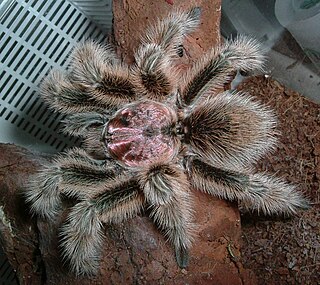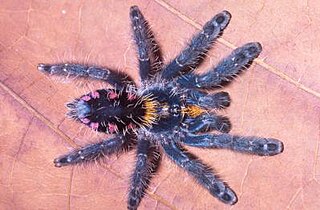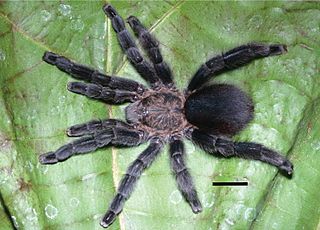
Avicularia is a genus of the family Theraphosidae containing various species of tarantulas. The genus is native to tropical Central and South America. Each species in the genus has very distinguishable pink foot pads.

Grammostola is a genus of South American tarantulas that was first described by Eugène Louis Simon in 1892. These medium- to large-sized spiders are native to tropical South America, and are usually brown in color, with pinkish or orangish-red hairs. The very docile Chilean rose tarantulas are popular as a beginner's spider among tarantula enthusiasts.

Barychelidae, also known as brushed trapdoor spiders, is a spider family with about 300 species in 42 genera. Most spiders in this family build trapdoor burrows. For example, the 20 millimetres (0.79 in) long Sipalolasma builds its burrow in rotted wood, with a hinged trapdoor at each end. The 10 millimetres (0.39 in) long Idioctis builds its burrow approximately 5 centimetres (2.0 in) deep, just below the high tide level, sealing the opening with a thin trapdoor.

Phormictopus is a genus of spiders in the family Theraphosidae (tarantulas) that occurs in the West Indies, mainly Cuba and Hispaniola, with three species probably misplaced in this genus found in Brazil and Argentina.

Tarantulas comprise a group of large and often hairy spiders of the family Theraphosidae. Currently, 1,010 species have been identified. The term "tarantula" is usually used to describe members of the family Theraphosidae, although many other members of the same infraorder (Mygalomorphae) are commonly referred to as "tarantulas" or "false tarantulas". Some of the more common species have become popular in the exotic pet trade. Many New World species kept as pets have setae known as urticating hairs that can cause irritation to the skin, and in extreme cases, cause damage to the eyes.
Iridopelma is a genus of Brazilian tarantulas that was first described by Reginald Innes Pocock in 1901.
Pachistopelma is a genus of Brazilian tarantulas that was first described by Reginald Innes Pocock in 1901. As of May 2020 it contains two species, found in Brazil: P. bromelicola and P. rufonigrum. They have a straight front eye row and males have a spinose spur on the first tibia. Females have two spermathecae lacking lobes or constrictions that have a slight curvature in the middle.
The Aviculariinae are a subfamily of spiders in the family Theraphosidae (tarantulas). They can be distinguished from other theraphosids by a number of characters. Their legs have no or few spines on the underside of the tibial and metatarsal joints of the legs. The last two leg joints have brushes of hairs (scopulae) that extend sideways, particularly on the front legs, giving them a spoon-like (spatulate) appearance. Females have two completely separated spermathecae.

Acanthoscurria is a genus of tarantulas that was first described by Anton Ausserer in 1871.
Typhochlaena is a genus of small-bodied tarantulas with an arboreal trapdoor lifestyle. All the species except for T. seladonia were first described by Rogério Bertani in 2012.
Typhoclaena amma is a species of the Aviculariinae, a subfamily of the Theraphosidae. The specific name refers to the project AMMA – arachnids and myriapods from Brazilian Atlantic rainforest carried out by the arachnologists from Museu Nacional, Rio de Janeiro, who collected the types.

Typhochlaena costae is a species of tarantula in the family Theraphosidae, subfamily Aviculariinae. It is native to Palmas, Tocantins state, Brazil. The species shows an arboreal trapdoor lifestyle.

Typhochlaena paschoali is a species of tarantula, in the subfamily Aviculariinae. It is native to Brazil.

Typhochlaena curumim is a species of tarantula, that is native to Mata do Pau-Ferro, Areia, in the state of Paraiba, Brazil. It is a member of the subfamily Aviculariinae.

Pachistopelma bromelicola is a species of tarantula, contained within the Aviculariinae subfamily. It is endemic to Brazil.

Pachistopelma rufonigrum is a species of theraphosid, contained within the Aviculariinae subfamily. It is endemic to Brazil.
Kochiana is a monotypic genus of Brazilian tarantulas containing the single species, Kochiana brunnipes. It was first described by C. L. Koch in 1841 under the name "Mygale brunnipes", and was transferred to its own genus in 2008. As of April 2020, it has only been found in Brazil.
Pterinopelma is a genus of Brazilian tarantulas that was first described by Reginald Innes Pocock in 1901. As of May 2020 it contains three species, found in Brazil: P. felipeleitei, P. sazimai, and P. vitiosum. It was removed from the synonymy of Eupalaestrus in 2011.
Ybyrapora is a genus of spiders in the family Theraphosidae (tarantulas), found in Brazil. Its species were formerly placed in the genus Avicularia.

Idiothele mira, also known as the blue-foot baboon or the trap-door tarantula, is a species of tarantula endemic to South Africa and is popularized by hobbyists for the striking blue coloration on the ventral side of the tarsi and metatarsi on each leg. Furthermore, the species is well known for belonging to one of two described genera of theraphosids that build a trapdoor, the other being Typhochlaena.












